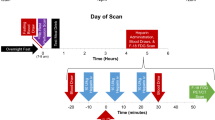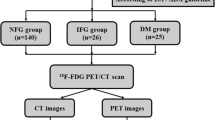Abstract.
Fluorine-18 fluorodeoxyglucose (FDG) imaging for the assessment of myocardial viability has become an integral part of the diagnostic and prognostic work-up of patients with ischaemic cardiomyopathy. To ensure good image quality, in particular in patients with diabetes mellitus, hyperinsulinaemic-euglycaemic clamping has been proposed. In this study we evaluated the safety and the image quality of cardiac FDG imaging during clamping in a large group of patients, including a subgroup with diabetes mellitus. The incidence of viability (on both a segment and a patient basis) was also determined for patients with and without diabetes mellitus. The safety and image quality of cardiac FDG studies during clamping were evaluated in 131 patients, including 19 with diabetes mellitus. Image quality was assessed visually and quantitatively using heart-to-lung (H/L), heart-to-liver (H/Li) and myocardium-to-background (M/B) ratios. Blood samples were drawn at baseline and at the time of FDG injection to determine levels of glucose, free fatty acids and insulin. The metabolic circumstances were optimal for FDG imaging: high insulin levels, low free fatty acid levels and glucose levels in the normal range (levels of substrates were comparable between patients with and patients without diabetes mellitus). No serious side-effects occurred in any patient. Image quality (assessed visually) was good in all patients. The quantitative parameters of image quality (H/L, H/Li and M/B) were comparable between patients with and patients without diabetes mellitus. The incidence of viability was high: 38% of patients without and 58% of patients with diabetes mellitus had substantial viability despite contractile dysfunction. It is concluded that cardiac FDG imaging during clamping is safe and provides excellent image quality, including in patients with diabetes mellitus. The incidence of viability is high, in particular in patients with diabetes mellitus.
Similar content being viewed by others

Author information
Authors and Affiliations
Additional information
Received 29 October and in revised form 18 December 2001
Electronic Publication
Rights and permissions
About this article
Cite this article
Bax, J.J., Visser, F.C., Poldermans, D. et al. Feasibility, safety and image quality of cardiac FDG studies during hyperinsulinaemic-euglycaemic clamping. Eur J Nucl Med 29, 452–457 (2002). https://doi.org/10.1007/s00259-001-0757-2
Published:
Issue Date:
DOI: https://doi.org/10.1007/s00259-001-0757-2



